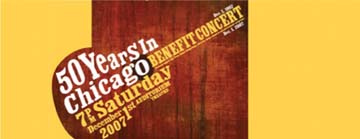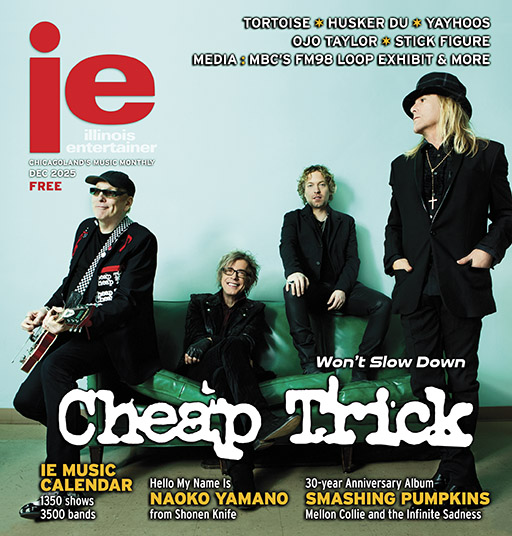Old Town School’s 50th
50 Folkin’ Years Of The Old Town School Of Folk

Frank Hamilton phones in for this interview about 45 minutes late. Seems the 73-year-old folk singer/teacher and his wife are running behind schedule due to a late night singing at a Democratic Socialists Of America labor rally in their homebase of Atlanta.
Appearing: Saturday December 1st at Auditorium Theatre in Chicago.
Things haven’t changed much for Hamilton in the 50 years since he, along with the late Win Stracke and Dawn Greening, founded Chicago’s Old Town School Of Folk Music. Still teaching, still performing, still committed to the tenets of folk-music tradition (including social activism), Hamilton awaits his return to Chicago for the December 1st celebration commemorating the School’s 50th anniversary. Taking place at the Auditorium Theatre, Hamilton will perform along with sets by Wilco’s Jeff Tweedy, School alum Roger McGuinn, and Bela Fleck, among others.
Hamilton can fondly recall the School’s inaugural fete back in 1957 with blues singer Big Bill Broonzy and bagpiper George Armstrong. The event solidified the School’s status as an institution and not just a group of guitar enthusiasts taking lessons under Hamilton’s watchful eye in the Greening home.
Growing up in California, Hamilton learned to play harmonica from Woody Guthrie (long before “This Land Is Your Land” became a schoolhouse staple and a young Bob Dylan made the life-changing pilgrimage to visit his withered hero), and studied under Bess Lomax Hawes, sister of celebrated folklorist and musicologist Alan Lomax.
When Hamilton followed Bob Gibson to Chicago for a stint at Albert Grossman’s (yeah, that Grossman) near North Side club, The Gate Of Horn, he soon found himself conducting classes at the home of Horn regular Dawn Greening. There he incorporated the teaching methods ingrained in him by his self-professed mentor, Hawes.
“I’ve always felt that music is not an exclusive club. Anybody can learn to play it and participate in it and enjoy it and be a part of it. And the other aspect of it is it’s a real index into what we call ‘democratic values.’ That people can learn to work together, play together, sing together, and create beautiful things together,” Hamilton explains.
Television and radio personality Win Stracke picked up on this ideology when taking lessons from Hamilton. He approached the instructor about opening a school and how he could build it around Hamilton’s group-based teaching style.
From these humble beginnings, the Old Town School Of Folk Music today resides in a multi-million-dollar facility in the former Hild Library at 4544 N. Lincoln. It houses an acoustically pristine, 400-plus-seat theater, the Different Strummer music store, and an exhaustive archive. This all in addition to the 6,000 students per week registered for 650 classes, not to mention the 200 concerts scheduled each year, according to Executive Director James Bau Graves. The old 909 W. Armitage location remains open — hosting children’s programs — in addition to satellite sites in Evanston and Western Springs. It’s a far cry from the original digs at 333 W. North Avenue.
Looking back, Hamilton is “shocked” the School has thrived this long (and there were low points, especially in the late ’70s and early ’80s when student enrollment dwindled and tuition revenues alone ceased to cut it in terms of keeping the institution afloat). Even back in ’57 Hamilton says he knew they were “trailblazing” by opening the School. The counter-culture — later figureheaded by Dylan and Joan Baez — had yet to establish mainstream acceptance.
“As a matter of fact, most of the time when I’d go to do interviews in the media, on the radio promoting the School, I was kind of ridiculed,” Hamilton remembers. “It was a tough gig . . . because the DJs had a real snotty attitude about it. They thought it was all beatnik stuff.”
Even those in folk’s inner circle had doubts about the School’s longevity. At first Hamilton declines to share the names of those naysayers, but, after prompting from his wife, admits Gibson and Grossman both bet it wouldn’t last more than six months.
“Aside from that, the most important thing to focus on is the fact that there were a lot of people in the Chicago area who made this happen. When you have a failure it becomes an orphan and when you have a success it has many different parents and in the case of the Old Town School I think it had numerous parents,” Hamilton says. “So as a result, because of the climate in Chicago in the artistic community and the station WFMT-[FM 98.7], I doubt very much sincerely whether this could have happened in any other part of the country.”
But what strikes Hamilton the most is how the School, despite growing and changing with the times, has adhered to the original concept set forth in ’57. “What I’m so amazed, also, is how it’s retained the values that [we] had when Win and I talked about the school years ago: that the School still is inculcating these values and updating and upgrading its method of education and it’s become more and more inclusive,” Hamilton says, happily trailing off.
The definition of folk music is broad. As Graves likes to say, “Folk music isn’t just guitars and banjos.” Indeed, the School’s course offerings reflect folk music’s myriad genres, from Latin jazz to Klezmer. Dance classes are even included. The annual summer Folks & Roots Festival showcases this diversity as well by inviting the likes of Patti Smith and British punks the Mekons in the last decade.
“I’ve had a few run-ins with the folk world over the years,” Mekons frontman Jon Langford chortles. “And the Old Town School in Chicago — it’s kind of the broad church of folk music. They’re quite willing to have people come in and mix it up a bit, especially me coming from basically [a] punk rock world initially. Being accepted in that community — it’s very nice.”
What hasn’t changed in the last 50 years is the notion of the “second half.” Students spend the first hour or so in lessons separated by their skill level. After a short break, everyone convenes in the concert hall for one massive sing-and-play-along. For singer-songwriter, former instructor, and current host of the School’s “Secret Country” concert series Robbie Fulks, the second half remains his favorite part.
“That was always really the icing on the cake — just sort of having that social blowout and having a drink and having fun with people,” Fulks relishes. “It’s not at all like a typical, raised-pinky cloistered experience in a little room with some geek showing you how to play some Led Zeppelin tablature. It’s really the opposite of that. It’s really social and warm and inviting and fun.”
Since joining the School last May as executive director, Graves agrees the School provides an outlet for people that they can’t find anywhere else. “This is where they come to recharge their social batteries every week. And people need that kind of thing in their lives. We’ve all got our homes and our places of work and I think the Old Town School is really a quintessential third place where people can go to sort of find a common bond with their neighbors,” Graves says.
Looking ahead, Graves hopes to implement an international-exchange program where artists from abroad can spend a semester in residency at the School teaching classes and performing and vice versa. And the subject of developing yet another space is at the forefront of Graves’ mind. Although he says plans for a new building are “a few years down the road,” the need for one is inevitable. “During primetime, which for us is in the evenings, we have a class running in pretty much every single room in our building that is available and we just need more space.”
As year 51 fast approaches, it’s fun to speculate who taking classes over there on Lincoln Ave. might someday join the ranks of famous students like McGuinn, Steve Goodman, and John Prine. But, as Hamilton argues, “When there’s a good school, somebody’s bound to get educated.” It’s not the stars who make the School what it is, it’s the entire collection of folks devoting their time and energy.
“Even if Bruce Springsteen came out of the School — he could maybe do a few sell-out concerts, but when he left the school would still be there,” Hamilton notes.
And it would no doubt be ready to excuse a few tardy students and teachers the next morning.
— Janine Schaults












So this is the place my alltime favorite
musician Jim (Roger) McGuinn started his
wonderful career! I hope sometime to visit
this School and to meet or speak Mr.McGuinn himself some day. I adored his
guitar music since 1965 and still do.
On my funeral his music will be played,
especially ‘Goin’ back’ and ‘My back pages’
I hope someone will be so kind to give me
his email or postadress: all my life I wanted to meet him; it would be a great honour.
thanks in advance!!
Fred de Jongh
Thuishaven 59
1186 ME Amstelveen, the Netherlands
email: freddejongh@hotmail.com